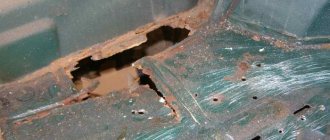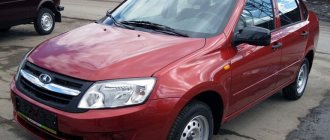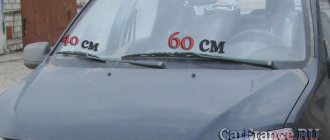Where does the anti-corrosion treatment process begin?
— We start by assessing the general condition of the body, put the car on a lift, remove all the plastic protection, dismantle everything unnecessary in order to carefully check the condition of the bottom, side members, arches, frame and other things. We draw up an assessment report, a rust map - if it has already appeared. If there are problems with the condition of the body, then after a preliminary discussion with the owner of the car, we send it for body repair. Sometimes welding is required. If the integrity of the body is lost, there is no point in doing treatment.
Middle class: Mazda 6
The first generation of the “six”, despite its Japanese origin, practically did not resist corrosion. The second and third inherited a “hereditary” defect, although to a much lesser extent.
However, in any case, the process for cars of this class is not as rapid as for state employees. The first “red swallows” may appear after two or three winters of operation on roads strewn with reagents. Serious damage occurs after 6–7 years with mileages exceeding 100,000 km. Oxidation occurs most quickly from the bottom.
In this price category, Mazda has many competitors who are ready to rust at the same speed or even faster. First of all, these are the Ford Mondeo of the same period and the slightly earlier “second” Nissan Teana.
Give some advice to car enthusiasts who have decided to undergo anti-corrosion treatment?
— Choose those anti-corrosion protection compounds that do not completely harden and remain elastic, especially for covering the bottom and arches. If the coating has become completely hard, then the protection has weakened. Microcracks will appear and any, even small, mechanical impact can destroy the entire protection. Condensation will form under the coating and corrosion will form even faster, but it will be more difficult to remove.
— Of course, we recommend contacting specialists both for the choice of compositions and for the processing itself. Good specialists are interested in you coming to them and recommending them to your car enthusiast friends. Therefore, they will select and use for you the highest quality compounds, of which there are a great many on the shelves, and not everyone will understand what is best for their car.
— The main advice, of course, is the recommendation to carry out anti-corrosion treatment even before the first signs of corrosion appear. Of course, all traces of rust will be removed, and the anticorrosive agent will stop this process. However, it’s like with an incurable disease - once it has appeared, it will be impossible to get rid of it forever. It is better to take preventive measures and prevent its occurrence.
The most painful place
Whatever car you choose, frequently inspect the traditional places where you can notice the first signs of corrosion: panel joints, bumpers, arches, hood trims, bottoms of doors, sills, A-pillars, roof edges front and rear. And, of course, the most painful place is under the rear license plate frame.
And still keep in mind: one day rust will get to any car with an iron body.
- Seven phrases to reduce the price of a used car, here.
- Are you faced with the problem of glass and brushes icing? Use BURNER heated brushes! To keep your side windows clean, purchase a windshield drain.
- A pragmatic way to improve the equipment of a car is roof rails. Our online store offers useful car accessories on the best terms.
Photo: manufacturing companies
It will rust behind them. Top 5 cars that rot quickly
Information from official representatives of AvtoVAZ
At the concern's factories, metal body elements are treated with a layer of galvanization. The low cost of the car does not allow covering the entire metal area; they protect the most vulnerable areas susceptible to corrosion:
• doors;• rear fenders;• rear wheel wells;• luggage compartment lids;• body protective screen;• floor;• protective cover;• frame parts;• rear fender groove.
The main vital structural elements are treated with a coating, which eliminates the question of whether the body of the Lada Grant is galvanized or not.
Inexpensive crossover: Skoda Yeti
Models from many brands are equally vying for the title of king of corrosion in this price category. Among them are Lifan X60, Renault Duster, Geely Emgrand X7, Mitsubishi ASX and even the best-selling crossover of recent years, Hyundai Creta.
Yeti became an anti-leader due to the risk of rapid corrosion - many claims were received during the warranty period.
Do not pay attention to the assembly location - it does not in any way affect the rate at which corrosion spots appear. And although factories quickly respond to complaints and in many cases modernize the technology, inexpensive models still do not have the chance to use the most reliable galvanizing option - hot galvanizing, when the entire body assembly is dipped into a bath of melt.
Interestingly, the features of the Yeti do not apply to other models of the Skoda brand. Octavia, for example, is a highly corrosion resistant machine. Rapid does not cause any particular complaints either.
Myth 2: A galvanized body does not rust.
Chromium, which is part of stainless steel or applied to the surface of galvanized steel, really effectively protects its surface from corrosion. But the fact is that car bodies are not made of stainless steel, the parts of which are simply difficult to weld together due to the presence of zinc.
Therefore, factories perform galvanic galvanization, as a result of which a layer of zinc up to 0.015 mm thick is formed on the surface of the steel. This zinc layer is quite economical in terms of production costs and provides good protection. However, it is easily damaged mechanically. And not only as a result of an accident, but also due to abrasive effects on the surface of the body.
Also, the zinc layer is damaged during operation, during which the body experiences various bending and deforming loads. Because of them, corrosion first appears at welding points and at joints - numerous power and moving elements of any body. Therefore, even a good galvanized body will never benefit from additional anti-corrosion protection.
The manager at the salon highly recommended that Grant be given anticorrosive treatment. What about the factory one?
I am glad to welcome you to the channel, dear friends! “But not on credit” is with you, and its regular author Evgeny Seleznev.
If you often read my channel, you know that I recently went to the dealer to buy a new Lada Granta with automatic transmission in the middle configuration with air conditioning.
The price tag upset me, of course, but that’s not what we’re talking about today. Without additional options, the cost of the car was 673,000 rubles. I repeat, this is a liftback with an automatic transmission in the “Comfort” version, which has air conditioning, an audio system, heated seats and two airbags.
When it came to discussing additional options, the manager advised doing three things. Firstly, set an alarm, which is quite logical. Secondly, install a normal crankcase protection, and not the piece that is installed there at the factory.
To be honest, I’m not sure that this is a necessary modification, because if you spend almost all your time driving around the city, then the factory protection will be enough for you.
Fortunately, in large Russian cities there are no gullies left powerful enough to break their entire bottom.
Features of anti-corrosion treatment
Regardless of whether the body is galvanized or not, certain rules must be followed. The optimal time for implementing anti-corrosion measures in LADA Granta is a dry and warm period. It is recommended to carry out the work annually or once every two years (as appropriate).
If the procedure involves treating external and unprotected body surfaces, then bitumen-based mastic is perfect. The process is not complicated, so it can be easily done at home. There are mastics both drying and lacking this quality. The latter options are characterized by sufficient elasticity, but are not resistant to mechanical factors. Application of mastic involves achieving a layer thickness of 0.4 mm, which allows for maximum noise insulation effect.
New Lada: Removing the Lada Granta radiator
To effectively treat hard-to-reach and hidden cavities on the body, it is recommended to use substances based on an oil structure. This allows you to effectively fill pores and cracks. Elastic mastics are also excellent, one of the advantages of which is the ability to effectively displace moisture. These processing agents have a paraffin or wax structure.
Budget class: Renault Logan/Sandero
The situation is similar to Granta: the “red rash” may come out in a couple of winters, or it may not come out in five. A sedan is more prone to corrosion than a hatchback. Rust appears on the welds of doors, doorways, doors from below, and in hidden cavities in thresholds. And also everywhere where the metal is not coated with a primer - primarily from the bottom.
Like Grante, Logan is recommended for additional anti-corrosion treatment. The same applies to the Nissan Almera, which is related in platform and close in price.
How much does anti-corrosion treatment cost and is there a guarantee after it?
— Complete anti-corrosion treatment of an SUV will cost approximately 15 thousand rubles. For a sedan, the price is, of course, lower - from 9 to 12 thousand rubles, depending on the size of the car and its condition. After processing, a certificate is issued, which indicates all the nuances of the car’s condition and all the measures that were applied. We recommend that our clients come for inspections, for new cars - once every 2-3 years, for old cars - at least once a year. It is better to do this in the spring, when the most types of destruction of the anti-corrosion layer and other nuances occur.
The most affordable option: Lada Granta
We are talking about the first generation—the second has not yet been sufficiently studied. Although unflattering reviews began to appear about it from owners of “one-year-old” cars.
Granta's body quickly rents out in those places where it is covered with sound insulation. Unpainted elements under the hood and on the bottom are the weakest point of the car. Thresholds and lower parts of doors last for two to three years.
Priming damaged areas
If the repair was local and small pockets of corrosion were removed, then priming work should not be extended to a large area. Sometimes it is enough to apply a coat of primer with a brush and sand it a little with fine sandpaper. From the bottom of the door and from the inside, this is also more acceptable, especially if there is no spray gun.
When priming is carried out with a spray gun, you should first protect the remaining parts of the car that will not be painted. A simpler option would be to give the Matiz to specialists, because specialized stations have everything necessary for such a procedure, from equipment to experienced personnel.
Dealers' opinion
The only remark is that some AvtoVAZ dealers in the capital honestly state that their product does not have a galvanized body at all. This is due to the low price of the car. Therefore, you need to be especially careful when choosing a car and check the manufacturer’s promises in practice.
If there is no galvanization as such, then it will be necessary to use additional semi-liquid protective agents that are applied to the metal surfaces of the car. They significantly increase the corrosion resistance of even those vehicles that have not been subjected to additional anti-corrosion treatment.
Do-it-yourself anti-corrosion treatment of Lada Granta (AVTOVAZ instructions)
AVTOVAZ reports that 32% of the weight of Lada Granta body parts is galvanized steel. Moreover, 75% of galvanized metal is hot-dip galvanized steel with 2-sided coating. The factory has a strong and durable anti-gravel coating on the bottom. Hidden body cavities are treated with anticorrosive. The muffler is made of stainless steel. However, if you are going to use the car for more than 8 years, consider additional anticorrosive protection. Do you know how to properly make anticorrosive Grants with your own hands?
Preparing the door to combat corrosion
Before doing anything, it is necessary to assess the extent of the damage and properly prepare the door for repair work. If there is rust only on the outside of the Matiz door, then all the work comes down to removing it to bare metal. This process can be carried out using special brushes for a drill or grinder. You will also need sandpaper of various grits.
If corrosion spreads from below or from the inside, then the door will also have to be disassembled. To do this, all trim and door controls are removed.
Removing corrosion from the inside looks similar to the option described above. The only point that needs to be taken into account is protecting the interior from dust and sparks that will fly there during the rust removal process. When all pockets of corrosion have been removed, you can move on to the next stage - restoring the geometry. Below we briefly describe two ways to restore the geometry of the door.
Factory galvanizing methods
Discussions about domestically produced cars do not subside. They argue about the Lada Granta, whether the body is galvanized, how the price corresponds to the quality, meanwhile the giant AvtoVAZ continues its strategy of improving the cars it produces and improving galvanization as well.
The factories use the following coating methods:
• thermal galvanizing – the most reliable;
• galvanization, when zinc is deposited from a solution on the surface of parts under the influence of electric current;
• coating with a primer with preliminary application of manganese, zinc and iron salts to the metal surface.











